Management Communication Strategies for a Multigenerational Workforce
VerifiedAdded on 2020/03/16
|13
|2349
|59
Report
AI Summary
This report examines the challenges and opportunities presented by a multigenerational workforce, with a specific focus on management communication strategies for motivating and retaining employees, particularly those from Generation X. The report delves into the attitudes, strengths, and weaknesses of Generation X employees, offering insights into effective communication media and decision-making preferences. It analyzes the importance of tailored motivational approaches, work-life balance, and feedback mechanisms to foster employee engagement and productivity within ABC Company. The report concludes by emphasizing the significance of understanding generational differences to optimize communication and achieve organizational goals. Relevant references are included to support the findings.
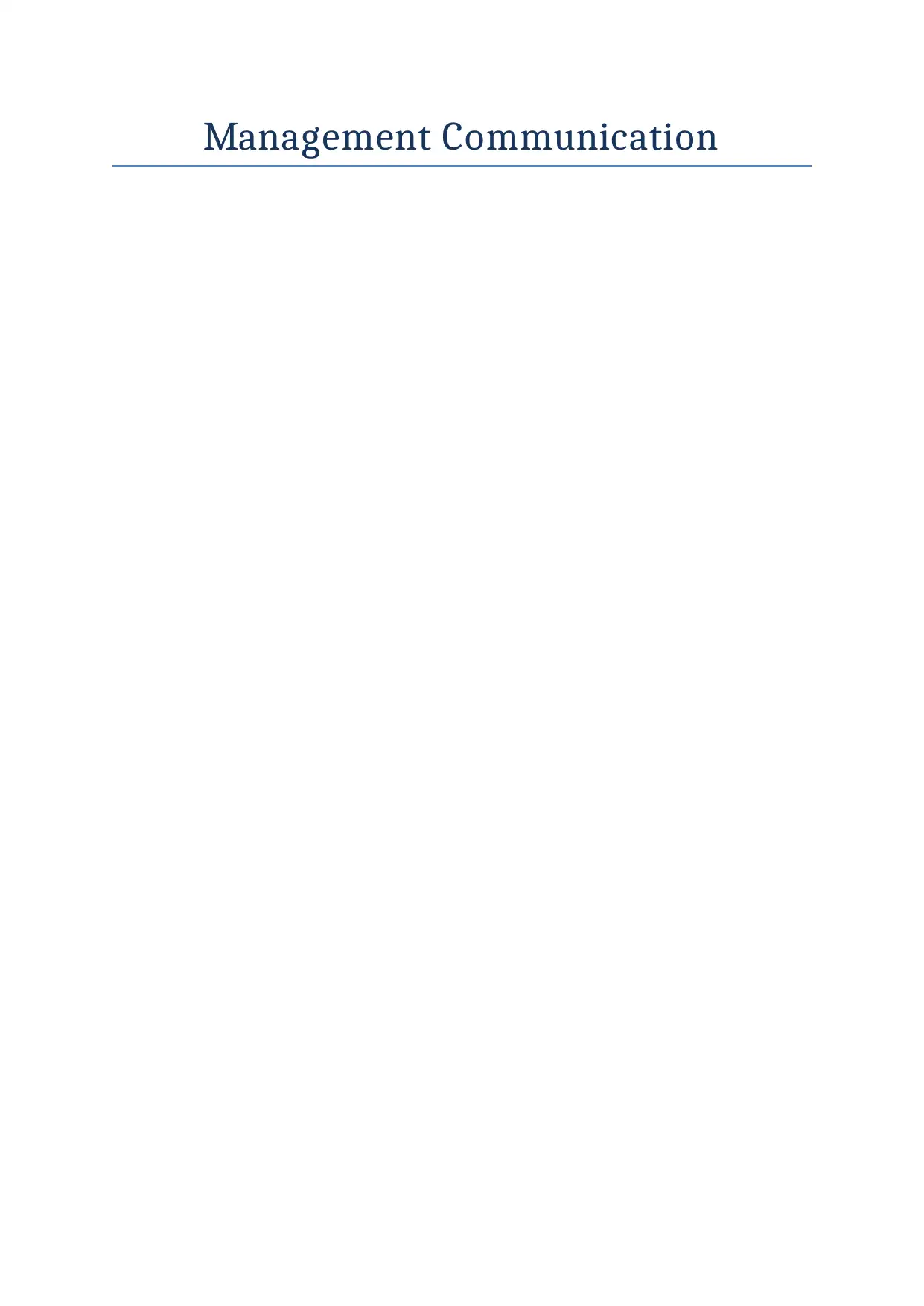
Management Communication
Paraphrase This Document
Need a fresh take? Get an instant paraphrase of this document with our AI Paraphraser
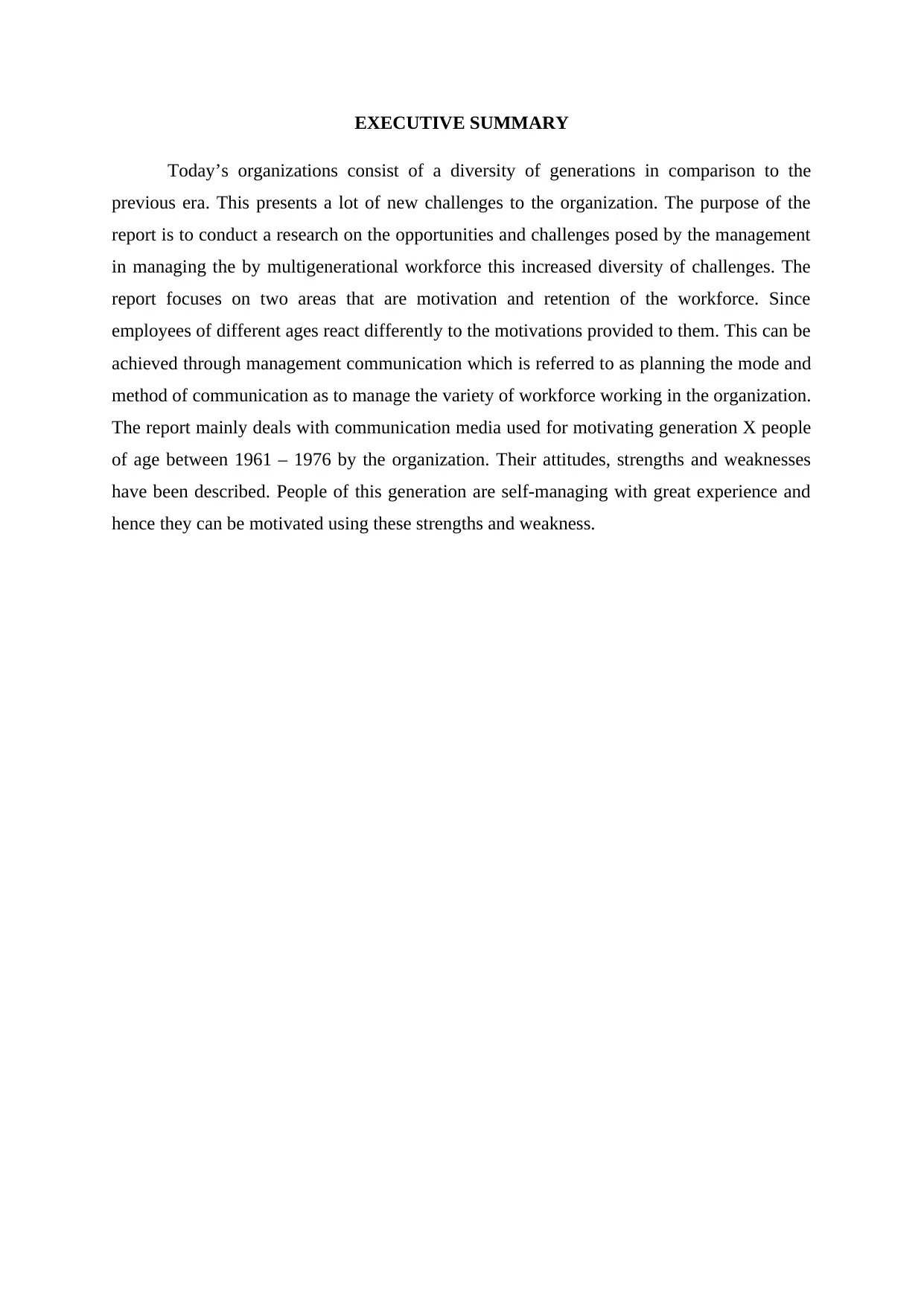
EXECUTIVE SUMMARY
Today’s organizations consist of a diversity of generations in comparison to the
previous era. This presents a lot of new challenges to the organization. The purpose of the
report is to conduct a research on the opportunities and challenges posed by the management
in managing the by multigenerational workforce this increased diversity of challenges. The
report focuses on two areas that are motivation and retention of the workforce. Since
employees of different ages react differently to the motivations provided to them. This can be
achieved through management communication which is referred to as planning the mode and
method of communication as to manage the variety of workforce working in the organization.
The report mainly deals with communication media used for motivating generation X people
of age between 1961 – 1976 by the organization. Their attitudes, strengths and weaknesses
have been described. People of this generation are self-managing with great experience and
hence they can be motivated using these strengths and weakness.
Today’s organizations consist of a diversity of generations in comparison to the
previous era. This presents a lot of new challenges to the organization. The purpose of the
report is to conduct a research on the opportunities and challenges posed by the management
in managing the by multigenerational workforce this increased diversity of challenges. The
report focuses on two areas that are motivation and retention of the workforce. Since
employees of different ages react differently to the motivations provided to them. This can be
achieved through management communication which is referred to as planning the mode and
method of communication as to manage the variety of workforce working in the organization.
The report mainly deals with communication media used for motivating generation X people
of age between 1961 – 1976 by the organization. Their attitudes, strengths and weaknesses
have been described. People of this generation are self-managing with great experience and
hence they can be motivated using these strengths and weakness.
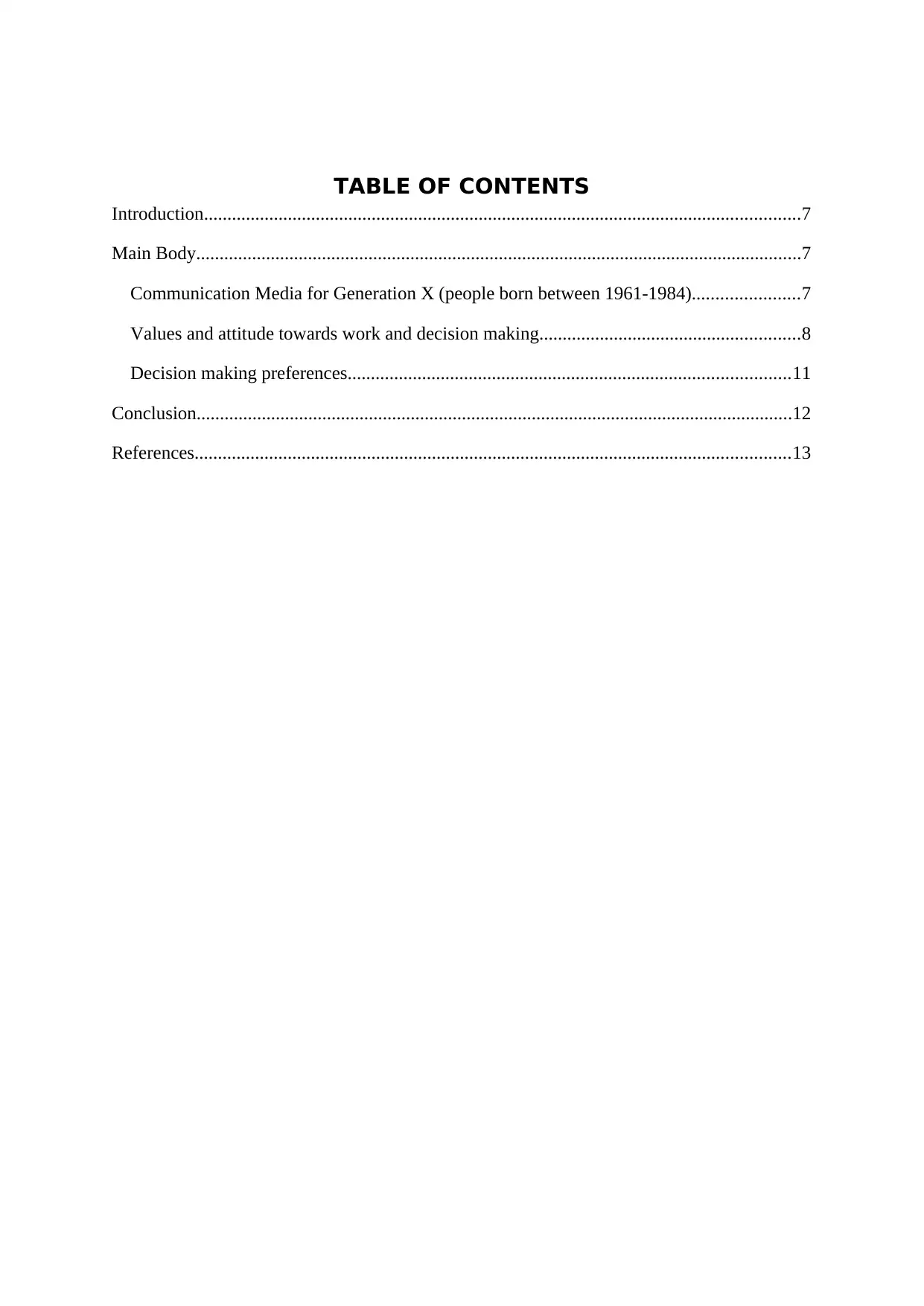
TABLE OF CONTENTS
Introduction................................................................................................................................7
Main Body..................................................................................................................................7
Communication Media for Generation X (people born between 1961-1984).......................7
Values and attitude towards work and decision making........................................................8
Decision making preferences...............................................................................................11
Conclusion................................................................................................................................12
References................................................................................................................................13
Introduction................................................................................................................................7
Main Body..................................................................................................................................7
Communication Media for Generation X (people born between 1961-1984).......................7
Values and attitude towards work and decision making........................................................8
Decision making preferences...............................................................................................11
Conclusion................................................................................................................................12
References................................................................................................................................13
⊘ This is a preview!⊘
Do you want full access?
Subscribe today to unlock all pages.

Trusted by 1+ million students worldwide
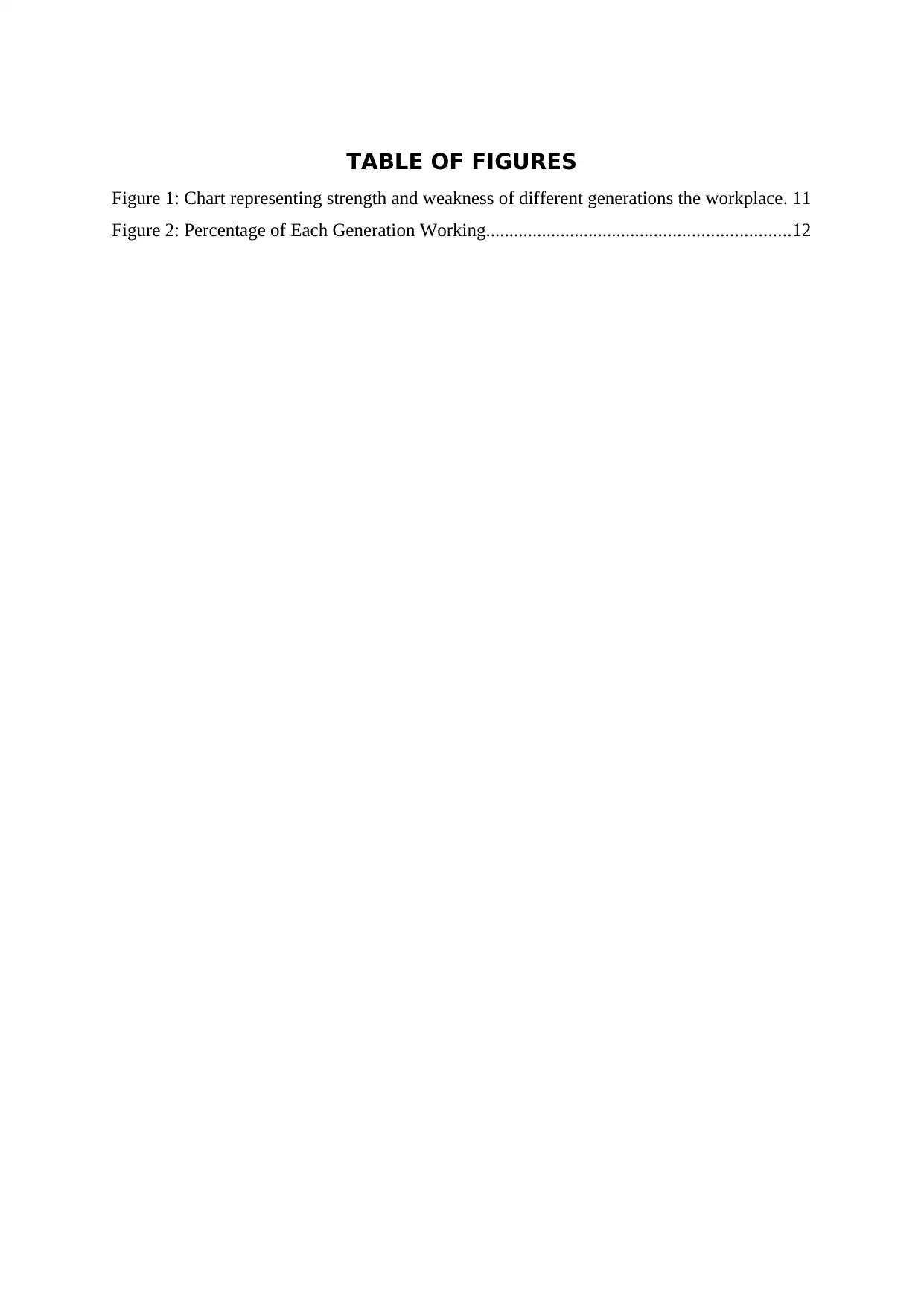
TABLE OF FIGURES
Figure 1: Chart representing strength and weakness of different generations the workplace. 11
Figure 2: Percentage of Each Generation Working.................................................................12
Figure 1: Chart representing strength and weakness of different generations the workplace. 11
Figure 2: Percentage of Each Generation Working.................................................................12
Paraphrase This Document
Need a fresh take? Get an instant paraphrase of this document with our AI Paraphraser
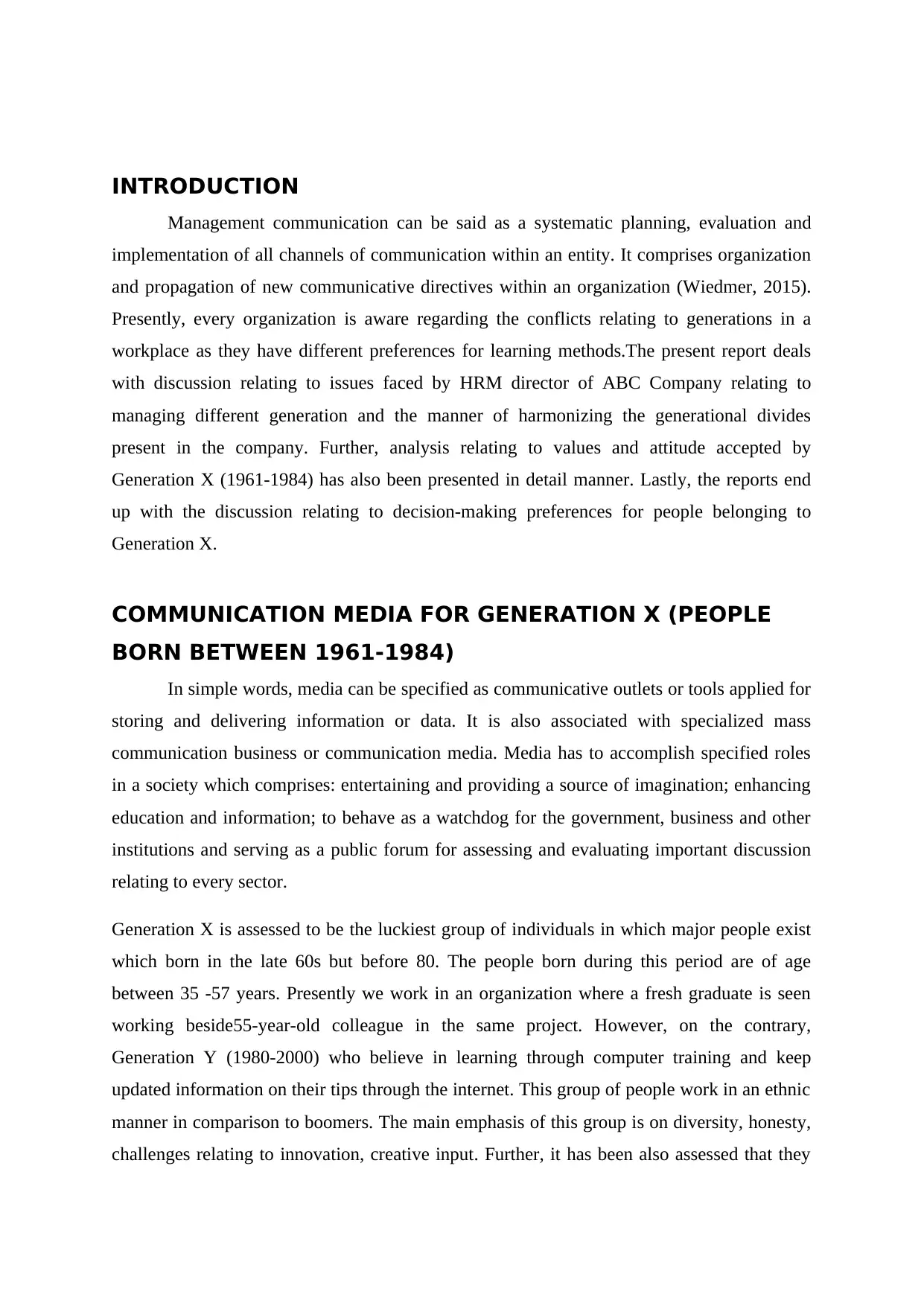
INTRODUCTION
Management communication can be said as a systematic planning, evaluation and
implementation of all channels of communication within an entity. It comprises organization
and propagation of new communicative directives within an organization (Wiedmer, 2015).
Presently, every organization is aware regarding the conflicts relating to generations in a
workplace as they have different preferences for learning methods.The present report deals
with discussion relating to issues faced by HRM director of ABC Company relating to
managing different generation and the manner of harmonizing the generational divides
present in the company. Further, analysis relating to values and attitude accepted by
Generation X (1961-1984) has also been presented in detail manner. Lastly, the reports end
up with the discussion relating to decision-making preferences for people belonging to
Generation X.
COMMUNICATION MEDIA FOR GENERATION X (PEOPLE
BORN BETWEEN 1961-1984)
In simple words, media can be specified as communicative outlets or tools applied for
storing and delivering information or data. It is also associated with specialized mass
communication business or communication media. Media has to accomplish specified roles
in a society which comprises: entertaining and providing a source of imagination; enhancing
education and information; to behave as a watchdog for the government, business and other
institutions and serving as a public forum for assessing and evaluating important discussion
relating to every sector.
Generation X is assessed to be the luckiest group of individuals in which major people exist
which born in the late 60s but before 80. The people born during this period are of age
between 35 -57 years. Presently we work in an organization where a fresh graduate is seen
working beside55-year-old colleague in the same project. However, on the contrary,
Generation Y (1980-2000) who believe in learning through computer training and keep
updated information on their tips through the internet. This group of people work in an ethnic
manner in comparison to boomers. The main emphasis of this group is on diversity, honesty,
challenges relating to innovation, creative input. Further, it has been also assessed that they
Management communication can be said as a systematic planning, evaluation and
implementation of all channels of communication within an entity. It comprises organization
and propagation of new communicative directives within an organization (Wiedmer, 2015).
Presently, every organization is aware regarding the conflicts relating to generations in a
workplace as they have different preferences for learning methods.The present report deals
with discussion relating to issues faced by HRM director of ABC Company relating to
managing different generation and the manner of harmonizing the generational divides
present in the company. Further, analysis relating to values and attitude accepted by
Generation X (1961-1984) has also been presented in detail manner. Lastly, the reports end
up with the discussion relating to decision-making preferences for people belonging to
Generation X.
COMMUNICATION MEDIA FOR GENERATION X (PEOPLE
BORN BETWEEN 1961-1984)
In simple words, media can be specified as communicative outlets or tools applied for
storing and delivering information or data. It is also associated with specialized mass
communication business or communication media. Media has to accomplish specified roles
in a society which comprises: entertaining and providing a source of imagination; enhancing
education and information; to behave as a watchdog for the government, business and other
institutions and serving as a public forum for assessing and evaluating important discussion
relating to every sector.
Generation X is assessed to be the luckiest group of individuals in which major people exist
which born in the late 60s but before 80. The people born during this period are of age
between 35 -57 years. Presently we work in an organization where a fresh graduate is seen
working beside55-year-old colleague in the same project. However, on the contrary,
Generation Y (1980-2000) who believe in learning through computer training and keep
updated information on their tips through the internet. This group of people work in an ethnic
manner in comparison to boomers. The main emphasis of this group is on diversity, honesty,
challenges relating to innovation, creative input. Further, it has been also assessed that they
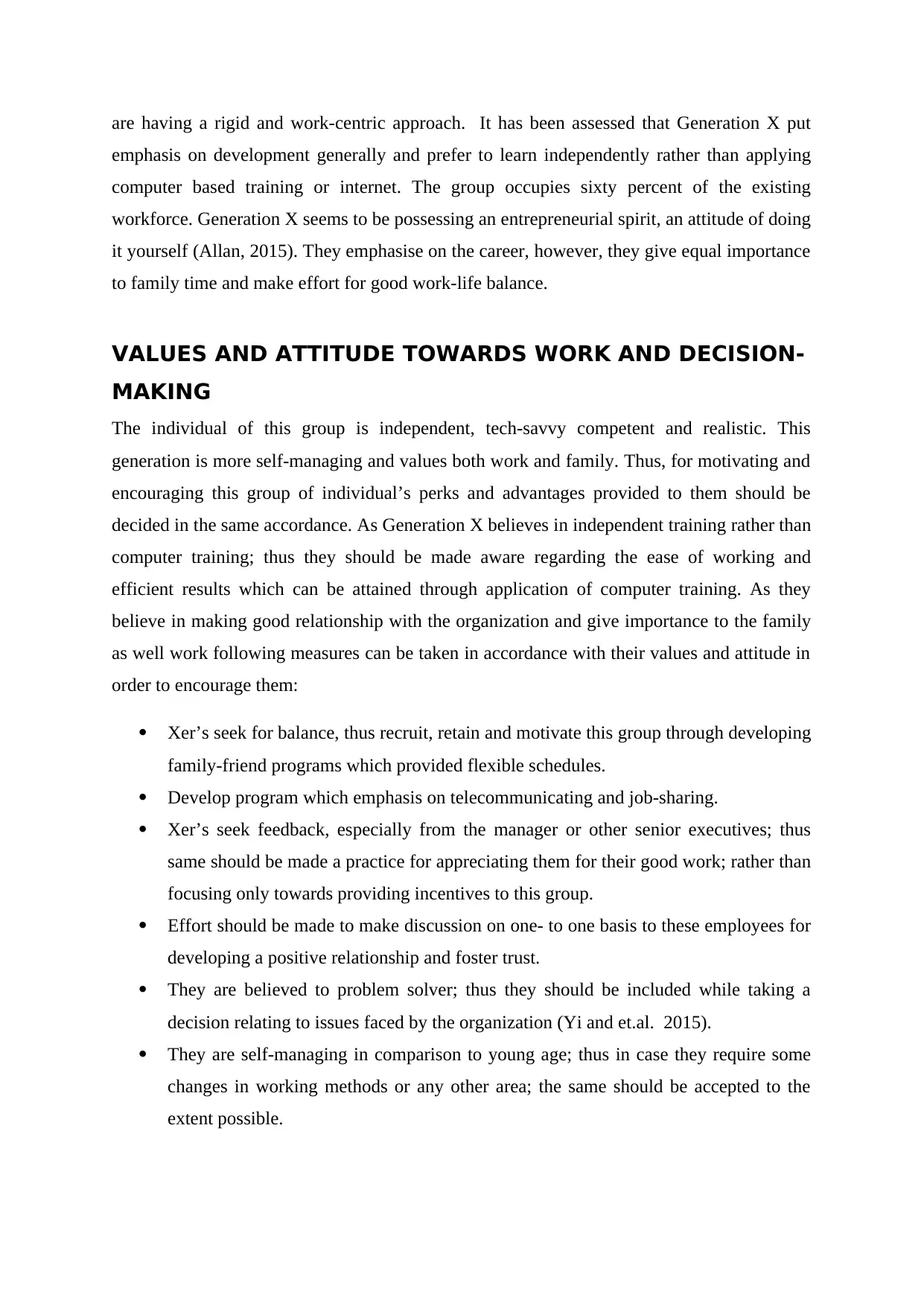
are having a rigid and work-centric approach. It has been assessed that Generation X put
emphasis on development generally and prefer to learn independently rather than applying
computer based training or internet. The group occupies sixty percent of the existing
workforce. Generation X seems to be possessing an entrepreneurial spirit, an attitude of doing
it yourself (Allan, 2015). They emphasise on the career, however, they give equal importance
to family time and make effort for good work-life balance.
VALUES AND ATTITUDE TOWARDS WORK AND DECISION-
MAKING
The individual of this group is independent, tech-savvy competent and realistic. This
generation is more self-managing and values both work and family. Thus, for motivating and
encouraging this group of individual’s perks and advantages provided to them should be
decided in the same accordance. As Generation X believes in independent training rather than
computer training; thus they should be made aware regarding the ease of working and
efficient results which can be attained through application of computer training. As they
believe in making good relationship with the organization and give importance to the family
as well work following measures can be taken in accordance with their values and attitude in
order to encourage them:
Xer’s seek for balance, thus recruit, retain and motivate this group through developing
family-friend programs which provided flexible schedules.
Develop program which emphasis on telecommunicating and job-sharing.
Xer’s seek feedback, especially from the manager or other senior executives; thus
same should be made a practice for appreciating them for their good work; rather than
focusing only towards providing incentives to this group.
Effort should be made to make discussion on one- to one basis to these employees for
developing a positive relationship and foster trust.
They are believed to problem solver; thus they should be included while taking a
decision relating to issues faced by the organization (Yi and et.al. 2015).
They are self-managing in comparison to young age; thus in case they require some
changes in working methods or any other area; the same should be accepted to the
extent possible.
emphasis on development generally and prefer to learn independently rather than applying
computer based training or internet. The group occupies sixty percent of the existing
workforce. Generation X seems to be possessing an entrepreneurial spirit, an attitude of doing
it yourself (Allan, 2015). They emphasise on the career, however, they give equal importance
to family time and make effort for good work-life balance.
VALUES AND ATTITUDE TOWARDS WORK AND DECISION-
MAKING
The individual of this group is independent, tech-savvy competent and realistic. This
generation is more self-managing and values both work and family. Thus, for motivating and
encouraging this group of individual’s perks and advantages provided to them should be
decided in the same accordance. As Generation X believes in independent training rather than
computer training; thus they should be made aware regarding the ease of working and
efficient results which can be attained through application of computer training. As they
believe in making good relationship with the organization and give importance to the family
as well work following measures can be taken in accordance with their values and attitude in
order to encourage them:
Xer’s seek for balance, thus recruit, retain and motivate this group through developing
family-friend programs which provided flexible schedules.
Develop program which emphasis on telecommunicating and job-sharing.
Xer’s seek feedback, especially from the manager or other senior executives; thus
same should be made a practice for appreciating them for their good work; rather than
focusing only towards providing incentives to this group.
Effort should be made to make discussion on one- to one basis to these employees for
developing a positive relationship and foster trust.
They are believed to problem solver; thus they should be included while taking a
decision relating to issues faced by the organization (Yi and et.al. 2015).
They are self-managing in comparison to young age; thus in case they require some
changes in working methods or any other area; the same should be accepted to the
extent possible.
⊘ This is a preview!⊘
Do you want full access?
Subscribe today to unlock all pages.

Trusted by 1+ million students worldwide
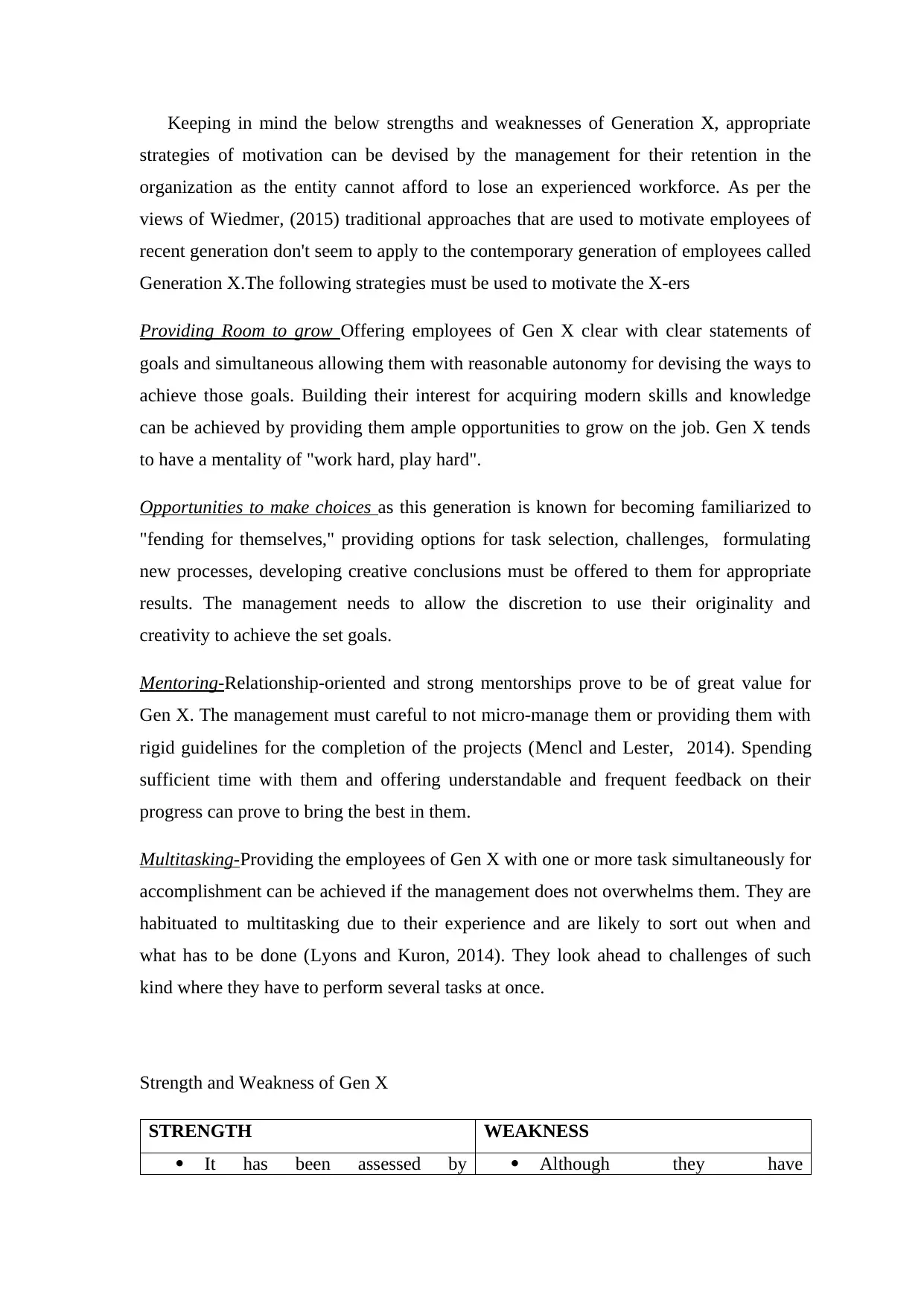
Keeping in mind the below strengths and weaknesses of Generation X, appropriate
strategies of motivation can be devised by the management for their retention in the
organization as the entity cannot afford to lose an experienced workforce. As per the
views of Wiedmer, (2015) traditional approaches that are used to motivate employees of
recent generation don't seem to apply to the contemporary generation of employees called
Generation X.The following strategies must be used to motivate the X-ers
Providing Room to grow Offering employees of Gen X clear with clear statements of
goals and simultaneous allowing them with reasonable autonomy for devising the ways to
achieve those goals. Building their interest for acquiring modern skills and knowledge
can be achieved by providing them ample opportunities to grow on the job. Gen X tends
to have a mentality of "work hard, play hard".
Opportunities to make choices as this generation is known for becoming familiarized to
"fending for themselves," providing options for task selection, challenges, formulating
new processes, developing creative conclusions must be offered to them for appropriate
results. The management needs to allow the discretion to use their originality and
creativity to achieve the set goals.
Mentoring-Relationship-oriented and strong mentorships prove to be of great value for
Gen X. The management must careful to not micro-manage them or providing them with
rigid guidelines for the completion of the projects (Mencl and Lester, 2014). Spending
sufficient time with them and offering understandable and frequent feedback on their
progress can prove to bring the best in them.
Multitasking-Providing the employees of Gen X with one or more task simultaneously for
accomplishment can be achieved if the management does not overwhelms them. They are
habituated to multitasking due to their experience and are likely to sort out when and
what has to be done (Lyons and Kuron, 2014). They look ahead to challenges of such
kind where they have to perform several tasks at once.
Strength and Weakness of Gen X
STRENGTH WEAKNESS
It has been assessed by Although they have
strategies of motivation can be devised by the management for their retention in the
organization as the entity cannot afford to lose an experienced workforce. As per the
views of Wiedmer, (2015) traditional approaches that are used to motivate employees of
recent generation don't seem to apply to the contemporary generation of employees called
Generation X.The following strategies must be used to motivate the X-ers
Providing Room to grow Offering employees of Gen X clear with clear statements of
goals and simultaneous allowing them with reasonable autonomy for devising the ways to
achieve those goals. Building their interest for acquiring modern skills and knowledge
can be achieved by providing them ample opportunities to grow on the job. Gen X tends
to have a mentality of "work hard, play hard".
Opportunities to make choices as this generation is known for becoming familiarized to
"fending for themselves," providing options for task selection, challenges, formulating
new processes, developing creative conclusions must be offered to them for appropriate
results. The management needs to allow the discretion to use their originality and
creativity to achieve the set goals.
Mentoring-Relationship-oriented and strong mentorships prove to be of great value for
Gen X. The management must careful to not micro-manage them or providing them with
rigid guidelines for the completion of the projects (Mencl and Lester, 2014). Spending
sufficient time with them and offering understandable and frequent feedback on their
progress can prove to bring the best in them.
Multitasking-Providing the employees of Gen X with one or more task simultaneously for
accomplishment can be achieved if the management does not overwhelms them. They are
habituated to multitasking due to their experience and are likely to sort out when and
what has to be done (Lyons and Kuron, 2014). They look ahead to challenges of such
kind where they have to perform several tasks at once.
Strength and Weakness of Gen X
STRENGTH WEAKNESS
It has been assessed by Although they have
Paraphrase This Document
Need a fresh take? Get an instant paraphrase of this document with our AI Paraphraser
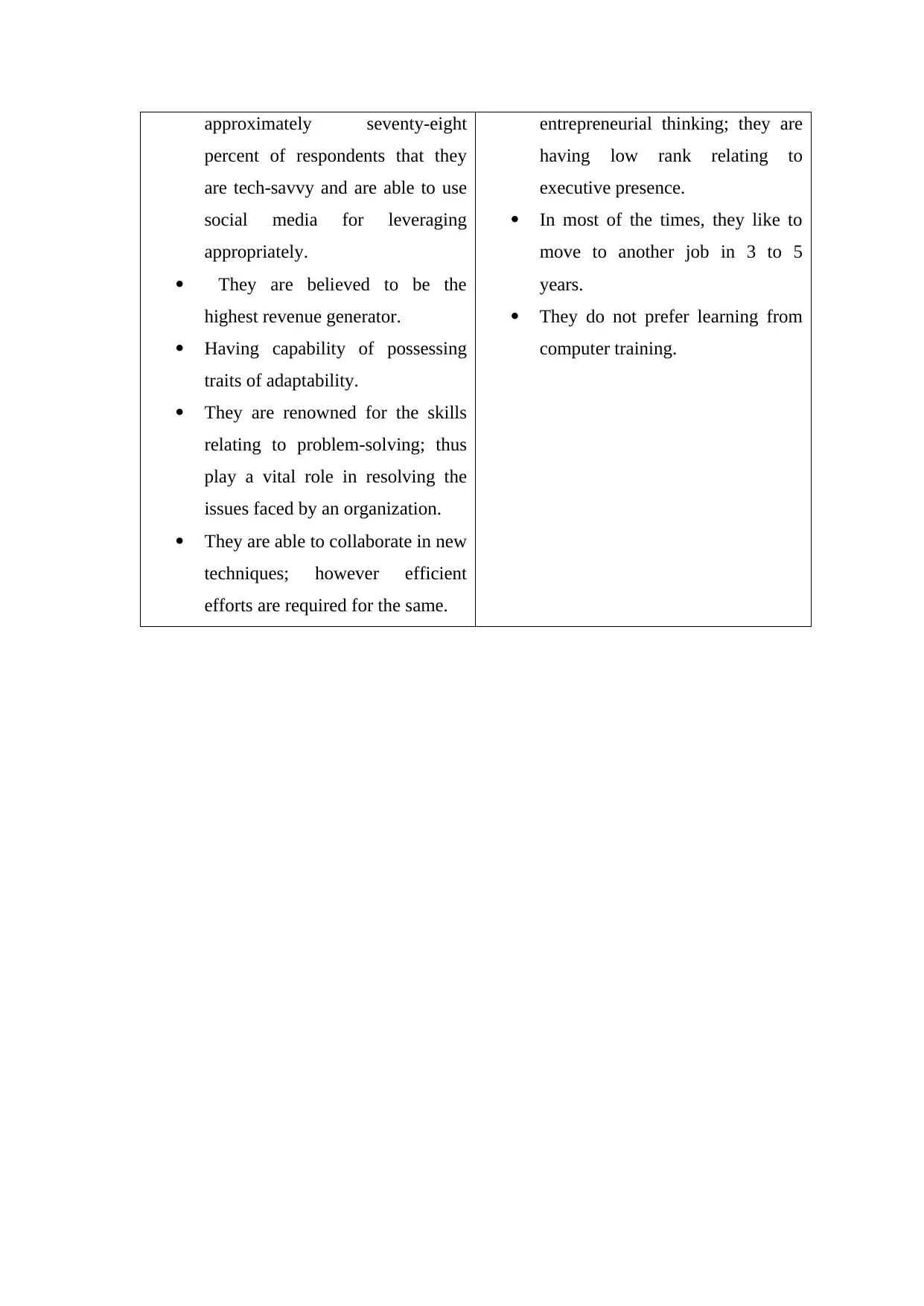
approximately seventy-eight
percent of respondents that they
are tech-savvy and are able to use
social media for leveraging
appropriately.
They are believed to be the
highest revenue generator.
Having capability of possessing
traits of adaptability.
They are renowned for the skills
relating to problem-solving; thus
play a vital role in resolving the
issues faced by an organization.
They are able to collaborate in new
techniques; however efficient
efforts are required for the same.
entrepreneurial thinking; they are
having low rank relating to
executive presence.
In most of the times, they like to
move to another job in 3 to 5
years.
They do not prefer learning from
computer training.
percent of respondents that they
are tech-savvy and are able to use
social media for leveraging
appropriately.
They are believed to be the
highest revenue generator.
Having capability of possessing
traits of adaptability.
They are renowned for the skills
relating to problem-solving; thus
play a vital role in resolving the
issues faced by an organization.
They are able to collaborate in new
techniques; however efficient
efforts are required for the same.
entrepreneurial thinking; they are
having low rank relating to
executive presence.
In most of the times, they like to
move to another job in 3 to 5
years.
They do not prefer learning from
computer training.
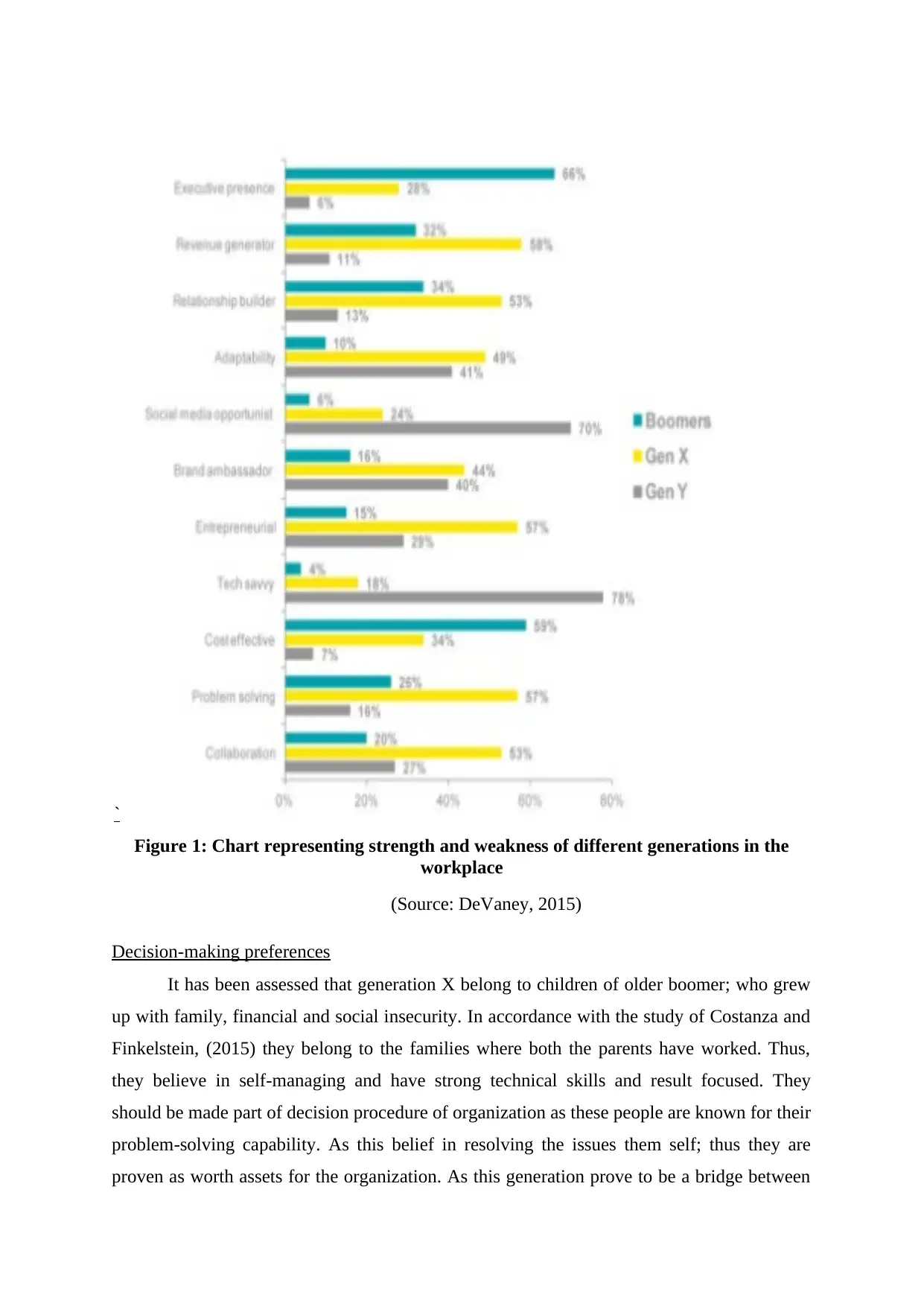
`
Figure 1: Chart representing strength and weakness of different generations in the
workplace
(Source: DeVaney, 2015)
Decision-making preferences
It has been assessed that generation X belong to children of older boomer; who grew
up with family, financial and social insecurity. In accordance with the study of Costanza and
Finkelstein, (2015) they belong to the families where both the parents have worked. Thus,
they believe in self-managing and have strong technical skills and result focused. They
should be made part of decision procedure of organization as these people are known for their
problem-solving capability. As this belief in resolving the issues them self; thus they are
proven as worth assets for the organization. As this generation prove to be a bridge between
Figure 1: Chart representing strength and weakness of different generations in the
workplace
(Source: DeVaney, 2015)
Decision-making preferences
It has been assessed that generation X belong to children of older boomer; who grew
up with family, financial and social insecurity. In accordance with the study of Costanza and
Finkelstein, (2015) they belong to the families where both the parents have worked. Thus,
they believe in self-managing and have strong technical skills and result focused. They
should be made part of decision procedure of organization as these people are known for their
problem-solving capability. As this belief in resolving the issues them self; thus they are
proven as worth assets for the organization. As this generation prove to be a bridge between
⊘ This is a preview!⊘
Do you want full access?
Subscribe today to unlock all pages.

Trusted by 1+ million students worldwide
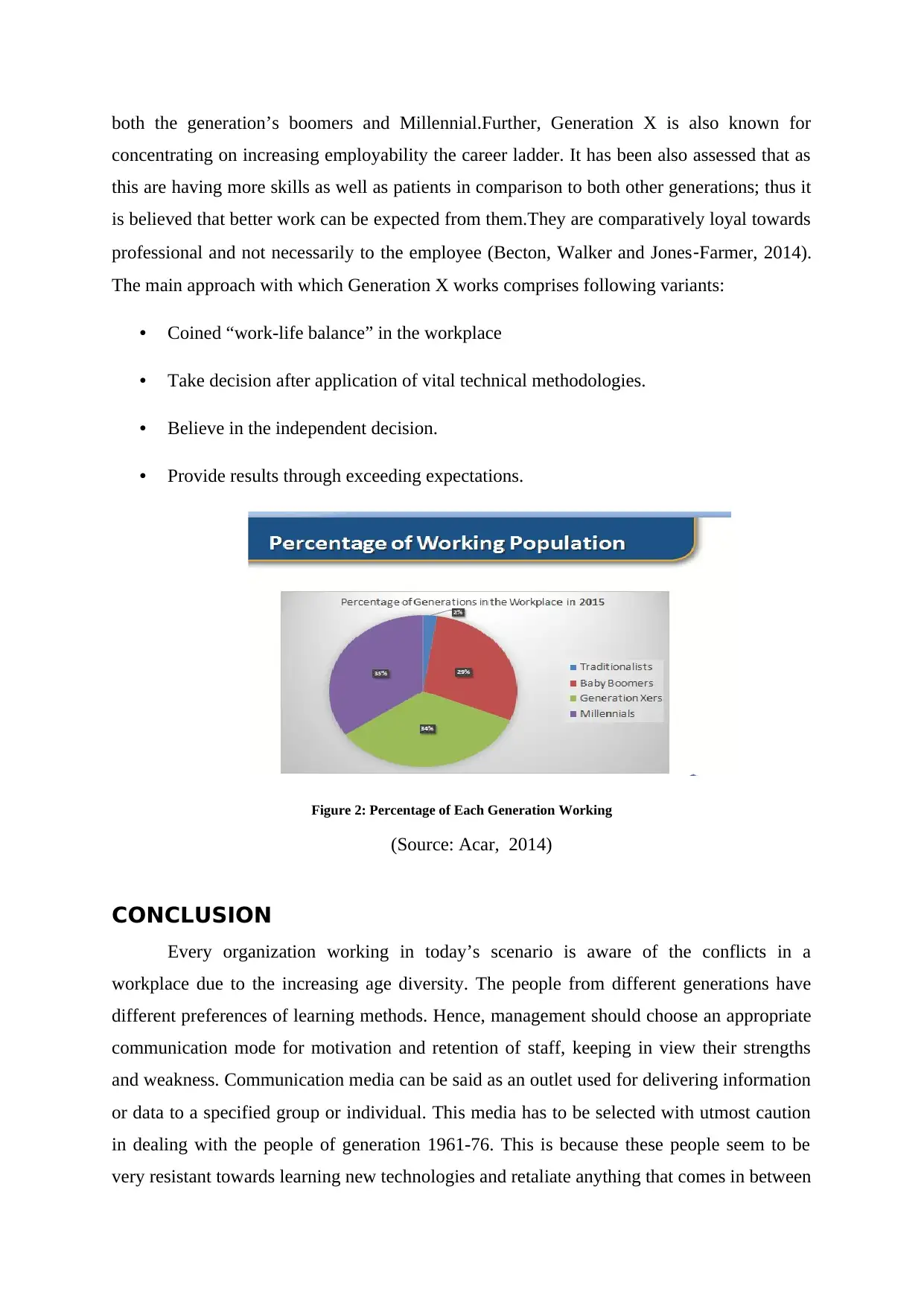
both the generation’s boomers and Millennial.Further, Generation X is also known for
concentrating on increasing employability the career ladder. It has been also assessed that as
this are having more skills as well as patients in comparison to both other generations; thus it
is believed that better work can be expected from them.They are comparatively loyal towards
professional and not necessarily to the employee (Becton, Walker and Jones‐Farmer, 2014).
The main approach with which Generation X works comprises following variants:
• Coined “work-life balance” in the workplace
• Take decision after application of vital technical methodologies.
• Believe in the independent decision.
• Provide results through exceeding expectations.
Figure 2: Percentage of Each Generation Working
(Source: Acar, 2014)
CONCLUSION
Every organization working in today’s scenario is aware of the conflicts in a
workplace due to the increasing age diversity. The people from different generations have
different preferences of learning methods. Hence, management should choose an appropriate
communication mode for motivation and retention of staff, keeping in view their strengths
and weakness. Communication media can be said as an outlet used for delivering information
or data to a specified group or individual. This media has to be selected with utmost caution
in dealing with the people of generation 1961-76. This is because these people seem to be
very resistant towards learning new technologies and retaliate anything that comes in between
concentrating on increasing employability the career ladder. It has been also assessed that as
this are having more skills as well as patients in comparison to both other generations; thus it
is believed that better work can be expected from them.They are comparatively loyal towards
professional and not necessarily to the employee (Becton, Walker and Jones‐Farmer, 2014).
The main approach with which Generation X works comprises following variants:
• Coined “work-life balance” in the workplace
• Take decision after application of vital technical methodologies.
• Believe in the independent decision.
• Provide results through exceeding expectations.
Figure 2: Percentage of Each Generation Working
(Source: Acar, 2014)
CONCLUSION
Every organization working in today’s scenario is aware of the conflicts in a
workplace due to the increasing age diversity. The people from different generations have
different preferences of learning methods. Hence, management should choose an appropriate
communication mode for motivation and retention of staff, keeping in view their strengths
and weakness. Communication media can be said as an outlet used for delivering information
or data to a specified group or individual. This media has to be selected with utmost caution
in dealing with the people of generation 1961-76. This is because these people seem to be
very resistant towards learning new technologies and retaliate anything that comes in between
Paraphrase This Document
Need a fresh take? Get an instant paraphrase of this document with our AI Paraphraser
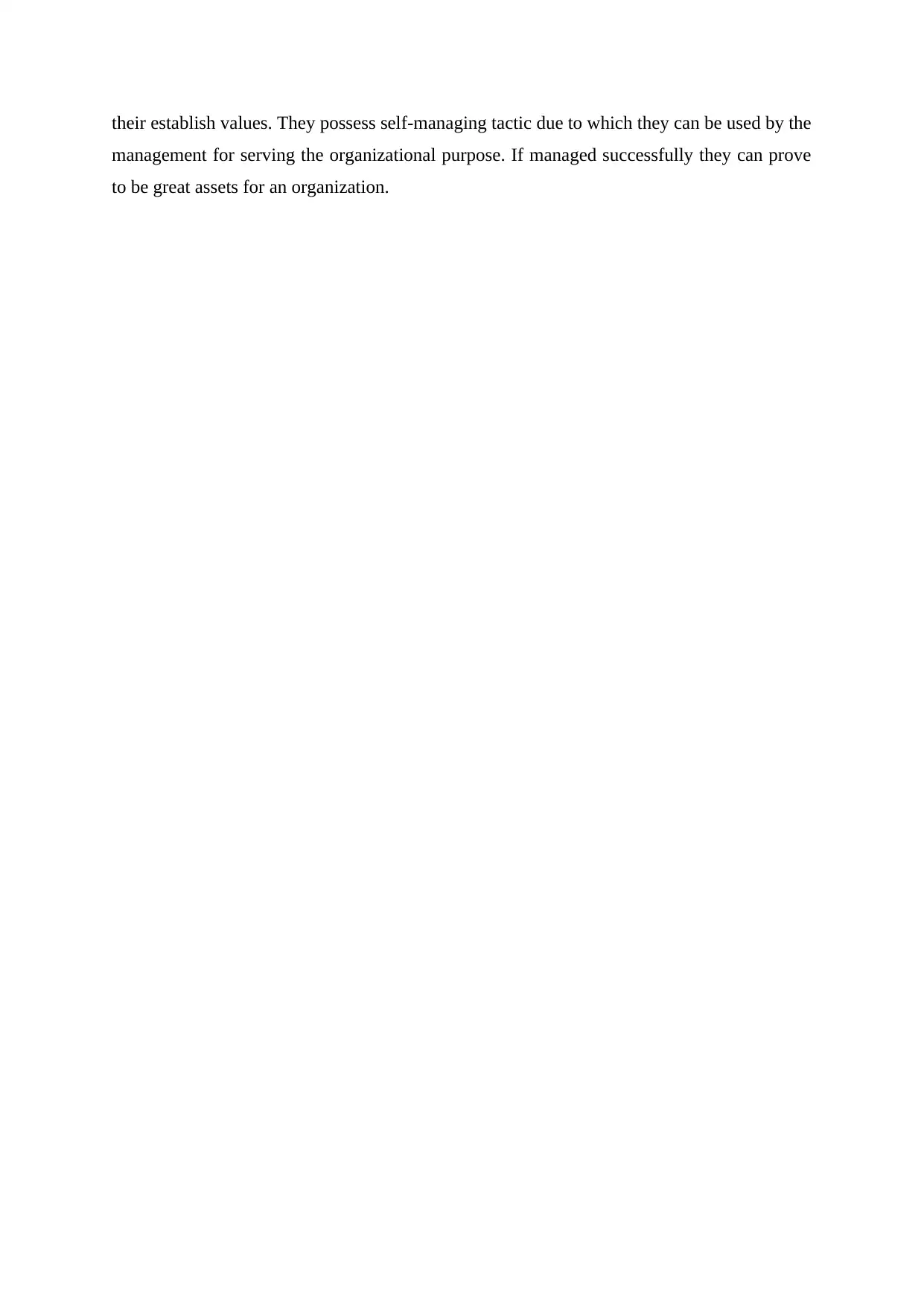
their establish values. They possess self-managing tactic due to which they can be used by the
management for serving the organizational purpose. If managed successfully they can prove
to be great assets for an organization.
management for serving the organizational purpose. If managed successfully they can prove
to be great assets for an organization.
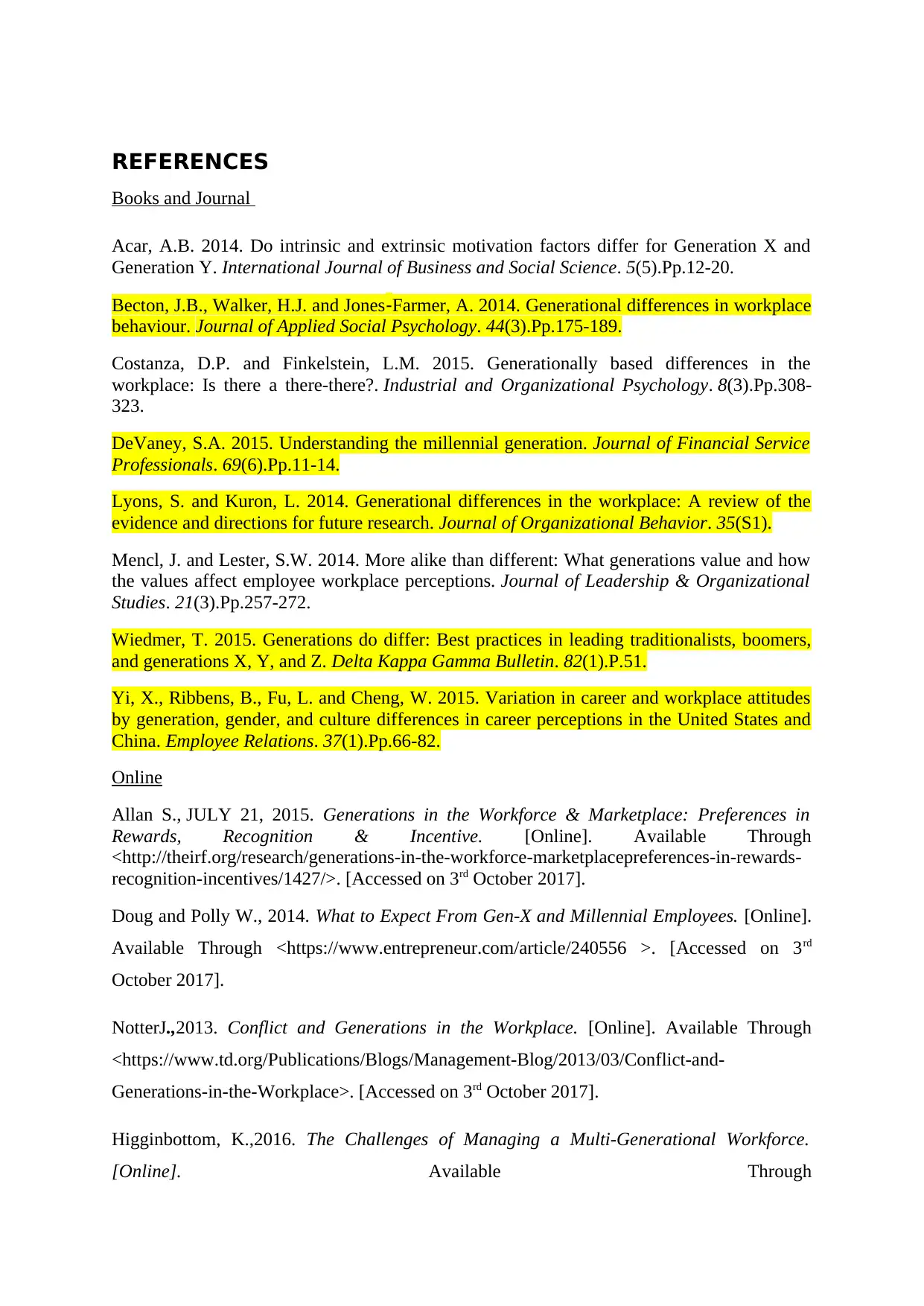
REFERENCES
Books and Journal
Acar, A.B. 2014. Do intrinsic and extrinsic motivation factors differ for Generation X and
Generation Y. International Journal of Business and Social Science. 5(5).Pp.12-20.
Becton, J.B., Walker, H.J. and Jones‐Farmer, A. 2014. Generational differences in workplace
behaviour. Journal of Applied Social Psychology. 44(3).Pp.175-189.
Costanza, D.P. and Finkelstein, L.M. 2015. Generationally based differences in the
workplace: Is there a there-there?. Industrial and Organizational Psychology. 8(3).Pp.308-
323.
DeVaney, S.A. 2015. Understanding the millennial generation. Journal of Financial Service
Professionals. 69(6).Pp.11-14.
Lyons, S. and Kuron, L. 2014. Generational differences in the workplace: A review of the
evidence and directions for future research. Journal of Organizational Behavior. 35(S1).
Mencl, J. and Lester, S.W. 2014. More alike than different: What generations value and how
the values affect employee workplace perceptions. Journal of Leadership & Organizational
Studies. 21(3).Pp.257-272.
Wiedmer, T. 2015. Generations do differ: Best practices in leading traditionalists, boomers,
and generations X, Y, and Z. Delta Kappa Gamma Bulletin. 82(1).P.51.
Yi, X., Ribbens, B., Fu, L. and Cheng, W. 2015. Variation in career and workplace attitudes
by generation, gender, and culture differences in career perceptions in the United States and
China. Employee Relations. 37(1).Pp.66-82.
Online
Allan S., JULY 21, 2015. Generations in the Workforce & Marketplace: Preferences in
Rewards, Recognition & Incentive. [Online]. Available Through
<http://theirf.org/research/generations-in-the-workforce-marketplacepreferences-in-rewards-
recognition-incentives/1427/>. [Accessed on 3rd October 2017].
Doug and Polly W., 2014. What to Expect From Gen-X and Millennial Employees. [Online].
Available Through <https://www.entrepreneur.com/article/240556 >. [Accessed on 3rd
October 2017].
NotterJ.,2013. Conflict and Generations in the Workplace. [Online]. Available Through
<https://www.td.org/Publications/Blogs/Management-Blog/2013/03/Conflict-and-
Generations-in-the-Workplace>. [Accessed on 3rd October 2017].
Higginbottom, K.,2016. The Challenges of Managing a Multi-Generational Workforce.
[Online]. Available Through
Books and Journal
Acar, A.B. 2014. Do intrinsic and extrinsic motivation factors differ for Generation X and
Generation Y. International Journal of Business and Social Science. 5(5).Pp.12-20.
Becton, J.B., Walker, H.J. and Jones‐Farmer, A. 2014. Generational differences in workplace
behaviour. Journal of Applied Social Psychology. 44(3).Pp.175-189.
Costanza, D.P. and Finkelstein, L.M. 2015. Generationally based differences in the
workplace: Is there a there-there?. Industrial and Organizational Psychology. 8(3).Pp.308-
323.
DeVaney, S.A. 2015. Understanding the millennial generation. Journal of Financial Service
Professionals. 69(6).Pp.11-14.
Lyons, S. and Kuron, L. 2014. Generational differences in the workplace: A review of the
evidence and directions for future research. Journal of Organizational Behavior. 35(S1).
Mencl, J. and Lester, S.W. 2014. More alike than different: What generations value and how
the values affect employee workplace perceptions. Journal of Leadership & Organizational
Studies. 21(3).Pp.257-272.
Wiedmer, T. 2015. Generations do differ: Best practices in leading traditionalists, boomers,
and generations X, Y, and Z. Delta Kappa Gamma Bulletin. 82(1).P.51.
Yi, X., Ribbens, B., Fu, L. and Cheng, W. 2015. Variation in career and workplace attitudes
by generation, gender, and culture differences in career perceptions in the United States and
China. Employee Relations. 37(1).Pp.66-82.
Online
Allan S., JULY 21, 2015. Generations in the Workforce & Marketplace: Preferences in
Rewards, Recognition & Incentive. [Online]. Available Through
<http://theirf.org/research/generations-in-the-workforce-marketplacepreferences-in-rewards-
recognition-incentives/1427/>. [Accessed on 3rd October 2017].
Doug and Polly W., 2014. What to Expect From Gen-X and Millennial Employees. [Online].
Available Through <https://www.entrepreneur.com/article/240556 >. [Accessed on 3rd
October 2017].
NotterJ.,2013. Conflict and Generations in the Workplace. [Online]. Available Through
<https://www.td.org/Publications/Blogs/Management-Blog/2013/03/Conflict-and-
Generations-in-the-Workplace>. [Accessed on 3rd October 2017].
Higginbottom, K.,2016. The Challenges of Managing a Multi-Generational Workforce.
[Online]. Available Through
⊘ This is a preview!⊘
Do you want full access?
Subscribe today to unlock all pages.

Trusted by 1+ million students worldwide
1 out of 13
Related Documents
Your All-in-One AI-Powered Toolkit for Academic Success.
+13062052269
info@desklib.com
Available 24*7 on WhatsApp / Email
![[object Object]](/_next/static/media/star-bottom.7253800d.svg)
Unlock your academic potential
Copyright © 2020–2025 A2Z Services. All Rights Reserved. Developed and managed by ZUCOL.





